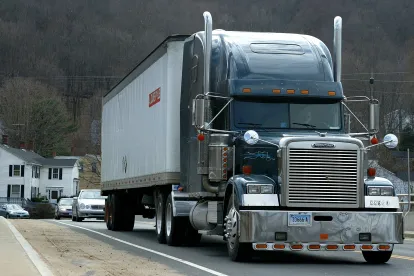Nine Steps You Can Take to Help Prevent Accidents
While semi trunks provide the vital service of moving goods across the country, when operated negligently they can also pose a substantial danger to other drivers around them.
Eighteen or more wheels and 400 to 600 horsepower. Semi trucks have large blind spots. They weigh a great deal—up to 40 tons of weight—which means they need more room to stop, turn, or maneuver, and that they can cause severe damage when they strike another vehicle. Not only that, semi truck drivers can spend up to 11 hours each day behind the wheel, leading to high rates of driver fatigue and the potential for severe accidents and injuries.
Even if you may drive defensively and follow the rules of the road, you cannot prevent every possible accident. Most semi truck accidents occur because of driver error: inebriated driving, ignoring the laws of the road, or driving distracted, for example.
You can’t make the operator of another vehicle drive more safely, but you can take steps to help keep you and your passengers safer when you share the road with big trucks.
1. Pay careful attention to semi trucks on the road.
Semi trucks take up a lot of space. You should always look for them and pay close attention to the actions they take—but many drivers overlook semi trucks until it’s too late.
When you share the road with a semi truck, take note of:
- The truck’s cargo. Pay attention to the type of cargo the truck may contain. Flatbed trucks, for example, may carry heavy, oversized cargo. If the driver or loader does not secure that cargo properly, it can cause a falling load accident, which may cause severe injuries to those in other vehicles. On a traditional 18 wheeler with a closed trailer, make note of the trailer’s doors. If you notice them opening or moving oddly, which could suggest that the loaders did not secure them properly, you may want to signal the driver or get out of the way.
- The driver’s behavior. Does the truck seem to drift from one side to the other? Is the driver behaving erratically in any way? If you spot the signs of distracted or inebriated driving in a truck driver, you may want to maneuver away from that driver as soon as possible to help reduce the risk of an accident.
- The truck’s position and signals. Always pay careful attention to a truck driver’s intended pathway. Many accidents, for example, occur as the truck driver attempts to turn the vehicle. Truck drivers may need to make wide turns, especially right turns. A vehicle that creeps into the space the truck driver needs to occupy during that turn may end up in an accident. If you notice a truck driver signaling his intent to get into your lane, you may need to signal him regarding your presence or, if possible, get out of the way quickly.
2. Give semi trucks plenty of room to maneuver safely.
Because of their larger size and weight, semi trucks need more room to maneuver safely on the road. Truck drivers need more space to stop or turn. As the driver of a smaller passenger vehicle, you can take some of the pressure off the truck driver and reduce the risk of accidents by offering plenty of room for the truck driver to maneuver.
This includes:
- Not pulling over in front of big trucks. Make sure you leave adequate room behind you before pulling over in front of a big truck, especially at a traffic light or stop sign. Truck drivers cannot stop their vehicles quickly, especially when pulling a heavy weight.
- Leaving room for truck drivers to change lanes when needed. If a truck driver signals that he needs to change lanes, do not try to run up further into the lane to prevent him from coming over. Instead, drop back in traffic and flash your lights to let the driver know when he has adequate room.
- Allowing the truck plenty of room to make turns. If you see a big truck signaling the driver’s intent to turn right, for example, make sure you do not pull up directly on the right side of the truck. Many truck drivers need to make wide right turns, and if you pull up alongside a truck, it can make it more difficult for the driver to turn safely.
- Giving the truck driver time and space to maneuver if he gets stuck. On tight city streets, in particular, truckers have little margin for error, and accidents can occur quickly. If you notice that a truck driver has maneuvered into a dangerous position or gotten stuck due to traffic, try to get your vehicle out of the way and leave room for him to maneuver.
To decrease your personal stress and tension when dealing with big trucks that share the road with you, try to leave plenty of time to complete your trip when you get behind the wheel. Rushing on a tight schedule can make it difficult to drive attentively and defensively, which may, in turn, make it difficult for you to take steps to help minimize the risk of an accident.
3. Know common truck blind spots.
Modern technology has undergone substantial advances, making it easier than ever for truck drivers to see the road around them, but those advances haven’t eliminated the hazard of trucking blind spots. Even trucks with cameras and collision warning may not give the trucker a complete view of the road around them.
Trucking blind spots include:
- The area directly behind the truck, including enough room for a passenger vehicle
- The area directly in front of the vehicle
- Areas on either side of the truck
If you cannot see the truck driver’s mirrors clearly, he likely cannot see you.
Try not to spend excessive time in a truck driver’s blind spots, even in tight traffic. Move your vehicle quickly out of the blind spot if you can, whether that means safely accelerating to move forward in traffic or dropping your rate of speed.
4. Follow all the rules of the road.
At high rates of speed, your risk of involvement in an accident increases substantially. The faster you drive, the harder it becomes to avoid common hazards on the road. You may also increase your risk of an accident if you attempt to rush through a red light or stop sign rather than waiting for your turn.
Follow the rules of the road carefully. Pay attention to street signs, including signs offering direction and speed limit signs. Keep in mind that ignoring the rules of the road makes your behavior unpredictable, which increases the risk that a truck driver will hit you.
5. Dim your brights.
On dark nights, you may turn on your brights to increase your ability to see the road or to make your vehicle more visible to others around you. When sharing the road with big trucks, however—especially if one occupies the road in front of you—turn your brights off and use your regular lights. Bright lights reflecting off the truck’s mirrors can blind the driver, making it more difficult to maneuver the large vehicle safely and setting the stage for an accident.
6. Pass trucks quickly, if you need to pass.
Don’t assume that the driver of a truck you’re passing knows you’re there. Because of blind spots, the truck driver may not always know that you moved—or even have seen your vehicle in the first place.
When you decide to pass a truck on the road, make sure you have plenty of room. Then, move your vehicle steadily past the truck until you can get in front of it. If you intend to move back into the truck’s lane, make sure you have adequate space before moving over. Remember that it can take a big truck far longer than your vehicle to come to a complete stop.
7. Use your turn signals.
If you need to slow down, change lanes, or turn, always use your signals to indicate your intent to other drivers. Truck drivers rely on your signals to determine their next moves. Tapping your brakes and putting on your turn signal lets a truck driver behind you know that you plan to turn soon and that the truck needs to slow down, giving you more room.
Likewise, if you find yourself struggling to get enough room to pass a big truck on the road, make sure you use your signals. Many truck drivers will slow their rate of speed and even flash their headlights to signal you when you can safely move your own vehicle over. Because they spend so many hours on the road each day, many truck drivers understand the potential struggle you face and will work to minimize the frustration you feel on the road, sharing the space as carefully as they can.
8. Do not tailgate a semi truck.
You might assume that you can stop fast enough to avoid an accident with a semi truck. After all, your small passenger vehicle stops much more readily than a larger truck. Unfortunately, many drivers suffer serious accidents when a semi truck does stop abruptly, perhaps because of another collision. In what’s called an “underride collision,” many smaller vehicles will even slip under the trailer, often causing severe injuries to the passengers in the vehicle. To help avoid the risk of this type of accident, keep your distance from semi trucks.
9. Slow down in bad weather.
Bad weather can prevent you from safely maneuvering your vehicle. Semi trucks can face even more risk on wet or icy roads. If a vehicle does swing out of the driver’s control, it can prove much more difficult for the driver to get it back under control again. Worse, wet roads can increase the risk of tires slipping or of a jackknife accident, in which the trailer swings around the cab and into other traffic lanes. Slowing down may decrease the general rate of speed on the road, which can help decrease the risk of accidents for truck drivers and other vehicles alike.




 />i
/>i

